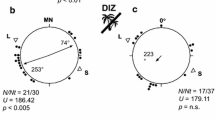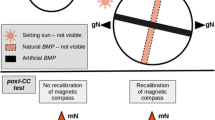Abstract
The difficulties to use the moon as a compass cue are well known: in the same lunar month, the moon never rises at the same hour, it does not show the same shape, and it is not always visible at night. At the equator, the use of the moon as an orienting cue is even more difficult than in the temperate latitudes. In addition to the difficulties listed above, it should be added (1) the relevant variation in its hourly azimuthal speed when the moon approaches the zenith, (2) the zenithal culmination (i.e., no angle on the horizontal plane), and (3) its changes in the culmination (from North to South and vice versa). Here, I present some experiments carried out using the equatorial sandhopper Talorchestia martensii during the zenithal culmination of the moon to clarify its use as an orienting cue taking into account the already demonstrated use of the magnetic field in the orientation of this species. Experiments were carried out in confined environment, with the magnetic sNorth deflected to East, in nights of zenithal culmination of the full moon. The results indicate that the moon is used together with the magnetic field by T. martensii when the azimuthal variation of the moon is ≤10°/h and its zenithal distance is >10°. However, when the moon’s azimuthal variation is >10°/h and its zenithal distance is ≤10°, the moon is no longer used as an orientating cue. The sole compass reference is now the magnetic field. Therefore, equatorial sandhoppers use the same relationship between orienting mechanisms to overcome the difficulties with astronomical orientation to the sun or the moon.
Significant statement
At the equator, the use of the moon as an orienting cue is difficult. Sandhoppers use the moon and the magnetic field only when the moon is far from the zenith; otherwise, they use the magnetic compass alone.




Similar content being viewed by others
References
Baker RR (1987) Integrated use of moon and magnetic compasses by the heart-and-dart moth Agriotis exclamationis. Anim Behav 35:94–101
Batschelet E (1981) Circular statistics in biology. AcademicPress, London
Craig PC (1971) An analysis of the concept of lunar orientation in Orchestoidea corniculata (Amphipoda). Anim Behav 19:368–374
Enright JT (1961) Lunar orientation of Orchestoidea corniculata. Biol Bull 120:148–156
Enright JT (1972) When the beachopper looks at the moon: the moon compass hypothesis. In: Galler SR et al (eds) Animal orientation and navigation. NASA SP-262, Washington, pp 523–555
Ercolini A (1964a) Ricerche sull’orientamento astronomico di anfipodi litorali della zona equatoriale. I l’orientamento solare in una popolazione somala di Talorchestia martensii Weber. Z vergl Physiol 49:138–171
Ercolini A (1964b) Ricerche sull’orientamento astronomico di anfipodi litorali della zona equatoriale. IV Compensazione differenziale giornaliera del moto azimutale del sole in una popolazione somala di Talorchestia martensii Weber. Redia 49:119–128
Merkel FW, Wiltschko W (1965) Magnetismus und richtungsfinden zugunruhiger rotkehlchen (Erithacus rubecula). Voglewarte 23:71–77
Papi F (1960) Orientation by night: the moon. Cold Spring Harbor Symp Quant Biol 25:475–480
Papi F, Pardi L (1953) Ricerche sull’orientamento di Talitrus saltator (Montagu) (Crustacea: Amphipoda). II Sui fattori che regolano la variazione dell’angolo di orientamento nel corso del giorno L’orientamento di notte L’orientamento diurno di altre popolazioni. Z vergl Physiol 35:490–518
Papi F, Pardi L (1959) Nuovi reperti sull’orientamento lunare di Talitrus saltator. Z vergl Physiol 41:583–596
Papi F, Pardi L (1963) On the lunar orientation of sandhoppers (Amphipoda, Talitridae). Biol Bull 124:97–105
Pardi L, Ercolini A (1965) Ricerche sull’orientamento astronomico di anfipodi litorali della zona equatoriale. II L’orientamento lunare in una popolazione somala di Talorchestia martensii Weber. Z vergl Physiol 50:225–249
Pardi L, Ercolini A (1966) Ricerche sull’orientamento astronomico di anfipodi litorali della zona equatoriale. III. L’orientamento solare in una popolazione di Talorchestia martensii Weber a sud dell’equatore (4° Lat. S.). Monitore zool Ital Suppl 74:80–101
Pardi L, Ugolini A, Faqi AS, Scapini F, Ercolini A (1988) Zonal recovery in equatorial sandhoppers: interaction between magnetic and solar orientation. In: Behavioral Adaptations to Intertidal Life (Chelazzi G and Vannini M edits). New York, Plenum, pp 79–92
Ugolini A (2001) Relationship between compass systems of orientation in equatorial sandhoppers. Anim Behav 62:193–199
Ugolini A (2002) The orientation of equatorial sandhoppers during the zenithal culmination of the sun. Ethol Ecol Evolution 14:269–273
Ugolini A, Boddi V, Mercatelli L, Castellini C (2005) Moon orientation in adult and young sandhoppers under artificial light. Proc R Soc London B 272:2189–2194
Ugolini A, Castellini C, Mercatelli L (2007) Moon orientation on moonless nights. Anim Behav 73:453–456
Ugolini A, Ciofini A (2015) Landscape vision and zonal orientation in the equatorial sandhopper Talorchestia martensii. J Comp Physiol A 202:1–6
Ugolini A, Fantini T, Innocenti R (2003) Orientation at night: an innate moon compass in sandhoppers (Amphipoda: Talitridae). Proc R Soc London B 270:279–281
Ugolini A, Galanti G, Mercatelli L (2012) The skylight gradient of luminance helps sandhoppers in sun and moon identification. J Exp Biol 215:2814–2819
Ugolini A, Melis C, Innocenti R, Tiribilli B, Castellini C (1999a) Moon and sun compasses in sandhoppers rely on two separate chronometric mechanisms. Proc R Soc London B 266:749–752
Ugolini A, Pardi L (1992) Equatorial sandhoppers do not have a good clock. Naturwissenschaften 79:279–281
Ugolini A, Vignali B, Posso P (1999b) Talorchestia tricornuta shoemaker (Amphipoda, Talitridae) from sandy shores of Gabon: compass mechanisms of orientation. Ethology 105:25–36
Zar JH (1984) Biostatistical analysis. Prentice – Hall, Englewood Cliffs
Acknowledgments
I wish to thank my friends, Drs. Carlo Astini and Miriam Martinelli, and the Consul of Italy in Djibouti, Mr Gianni Rizzo, for the facilities that allowed this research possible. I also wish to thank Drs. Annamaria Nistri and Paolo Agnelli (Natural History Museum, Zoological Section, University of Firenze) who assisted me during the most part of the experiments. Many thanks are due to Prof. Wolfgang Wiltschko (Frankfurt University) for his critical reading of the manuscript and to Prof. Alberto Righini (Dept of Physics and Astrophysics, University of Firenze) for his important contribution in clarifying some astronomical aspect of the moon.
Author information
Authors and Affiliations
Corresponding author
Ethics declarations
Funding
Funds were provided by the University of Firenze (local funds ex-60 %).
Conflict of interest
The author declares that he has no conflict of interest.
Ethical approval
N/A
Additional information
Communicated by W. Wiltschko
Rights and permissions
About this article
Cite this article
Ugolini, A. The moon orientation of the equatorial sandhopper Talorchestia martensii Weber. Behav Ecol Sociobiol 70, 1699–1706 (2016). https://doi.org/10.1007/s00265-016-2175-2
Received:
Revised:
Accepted:
Published:
Issue Date:
DOI: https://doi.org/10.1007/s00265-016-2175-2




